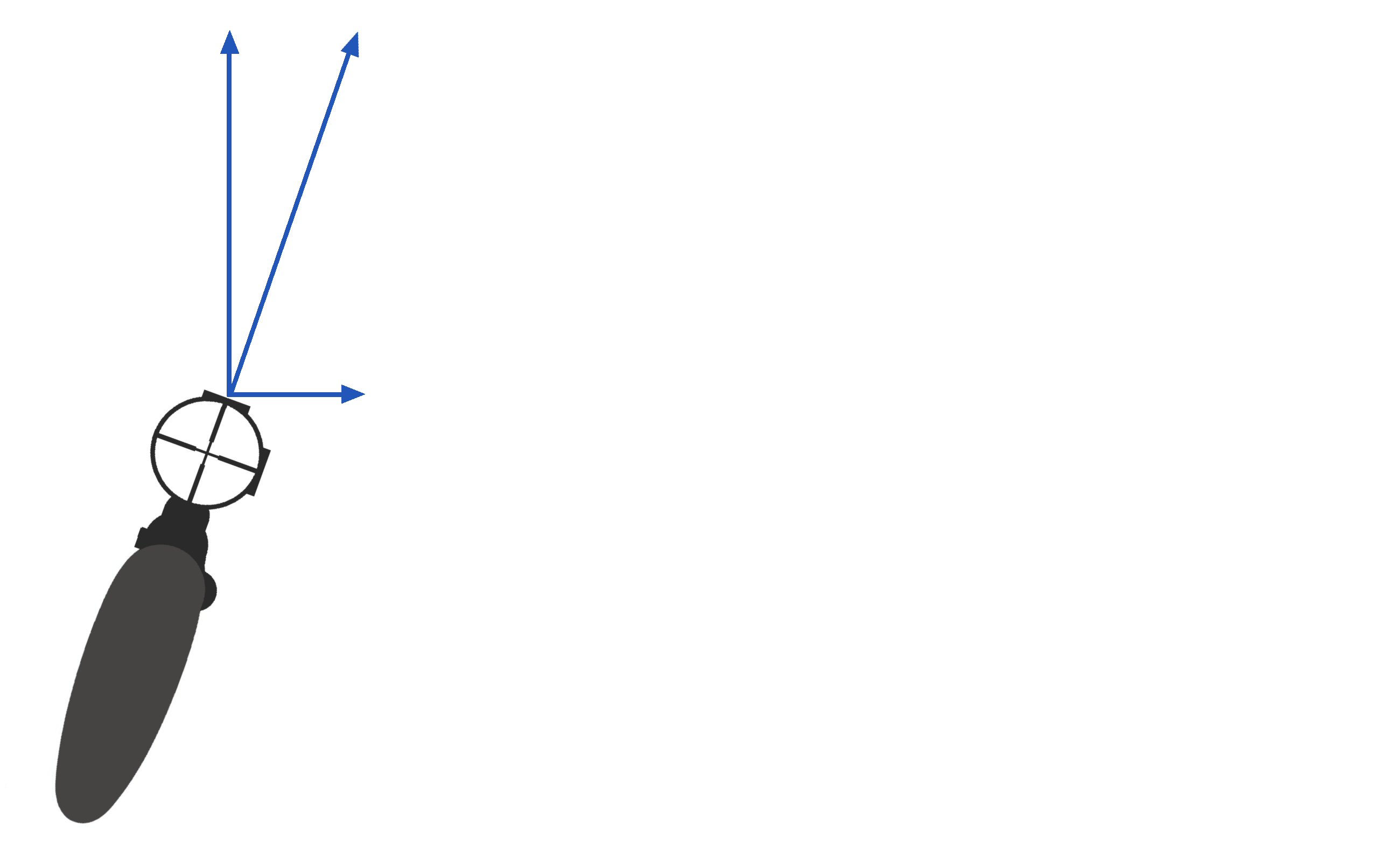I'm not sure if this guy is wrong, or I just missed the point he's making.
If the scope isn't centered horizontally above the bore, when the bullet is fired it will have to travel horizontally in order to hit whatever the zero point is, and beyond the zero point will continue to travel horizontally away from the line of aim.
An analogy is 2 lazer beams, one fixed and one tiltable, acting as our bore and scope. If there is a distance beween each lazer (same scenario as distance between scope and bore) one of the beams will have to be tilted so that the beams cross at a point, say 100m, and this is our point of aim. Beyond the 100m, the beam that is tilted carries on it's tilted path away from the fixed beam. If the lazers are in line horizontally (i.e directly one above the other), we only have vertical deviation to worry about downrange, and this is what the sight height in our calculations (ballistic apps etc) accounts for. However if the lazers aren't horizontally alligned (i.e they're sort of beside each other rather than directly on top, we would need to take that in to consideration with our calculations too as a sight-off-to-the-left-or-right measurement.
Maybe he did say something about correcting for the horizontal difference between bore and scope and I just missed it?
Welcome guest, is this your first visit? Create Account now to join.
Welcome to the NZ Hunting and Shooting Forums.
Search Forums
User Tag List
+ Reply to Thread
Results 1 to 15 of 17
Thread: Rifle canted, scope level
-
14-05-2020, 03:29 PM #1
 Rifle canted, scope level
Rifle canted, scope level
-
-
14-05-2020, 05:14 PM #2Member

- Join Date
- Feb 2018
- Location
- Taranaki
- Posts
- 626
Im the same as Muzza. Both prone and standing i have the rifle slightly titled to the left, it fits better in my shoulder. So i align the scope to how its shouldered. As long as i hold the scope near to level for most shooting and level for longer range its fine.
Its only an issue if you set it up straight then cant the rifle over and shoot. At longer ranges its enough to miss target completely.
-
14-05-2020, 06:03 PM #3
Have gazed thru some atrociously set up scopes. Have turned to the owner/owners and asked "is that alright to you?" Mostly the reply is " yeah yeah."
-
16-05-2020, 07:46 AM #4
-
16-05-2020, 09:16 AM #5
Most Running Target shooters have their rifles set up with a few degrees of cant. This is so you can lift to the shoulder and sight without having to tilt your head to the side. Less body movement required during the lift and less strain on muscles gives a fraction more time to acquire the target and a smoother track. In fast runs, you only have 2.5 seconds to lift, acquire and fire. The distance to target is always the same so once the rifle is zeroed, all good.
I can’t imagine operating with cant and varying distances because your scope adjustments are going to have to be in both axis.10MRT shooters do it 60 times, in two directions and at two speeds.
-
16-05-2020, 10:59 PM #6Member

- Join Date
- Dec 2011
- Location
- Southern Alps
- Posts
- 4,942
If your scope centre is at a height of 1.75 inchs to centre of yr barrel bore.And yr scope vertical line is 8 degrees off plumb which is really easy to see.The length of the circumference line on a circle of a radius of 1.75inchs between plumb and yr 8 degrees is only about 1/4 of a inch.
So if you zeroed at a 100yds,your bullet at 200yds will only be a 1/4 of a inch to left or right.So scopes that are 1 or 2 degrees off plumb to bore you never notice out to 500yds.
-
20-05-2020, 11:19 PM #7
The Bofors L/60 comes to mind when cant and horizontal components to sighting systems are mentioned.

I think this topic is worth a drawing to provide a pictorial explanation of the effect the earlier posters have described.
Below is an exaggerated diagram of the situation when a rifle and scope combination is consistently canted over. I say consistently, meaning that it has also been zeroed when held that way. This is the view looking down on the rifle and scope from directly above. For the purposes of this explanation, the scope has been attached to this rifle with incredibly tall rings and because of this, only slightly rotating the rifle around its long axis (canting) has moved the scope off to one side of the rifle as shown. In a real life situation the cant may be as in the video – or perhaps so slight for it to only just be noticeable that the scope is not positioned directly above the rifle. However any amount of cant will have a similar but proportionally lesser effect to the one shown, and for the same reason.

Perhaps in the video the comments “doesn’t matter” and “point of impact will simply not change at distance” when discussing the effect of cant could perhaps better have been replaced with “likely to be insignificant” as @Trout highlights with a solid example.
The blue line represents the line of sight. The brown line is the path the bullet will take. Where the lines cross is the distance at which the rifle/scope combination has been zeroed in a horizontal plane. Because the diagram is looking directly down on the firearm, the rise and fall of the bullet due to gravity cannot be shown. The scope body remains locked parallel to the rifle by the rings, so here we have to envisage that the angle the blue line-of-sight is making to the scope will be entirely through the adjustments internal to the scope, primarily the windage adjustment.
In the same way that a scope is zeroed to have the line of sight and the bullet’s path cross in the vertical plane, so any amount of cant that has the scope positioned off to the side of the rifle to ANY degree may also be zeroed out in the horizontal plane, but at only one distance. Beyond this the path of the bullet and the line of sight continue to diverge.
Another aspect raised that deserves a diagram is the inadvertent effect the elevation turret then has on windage if the rifle/scope combination is canted.

I’m not sure this needs any further explanation, but I’ll go ahead anyway. When the elevation turret pictured above is adjusted to compensate say for increased drop at greater range - by lowering the apparent position of the reticle and correspondingly raising the barrel to maintain the sight picture - then a measure of left or right change in the POI will also be introduced on a canted rifle.
@ishoot10s doesn’t identify which of the above two effects will also require a windage correction if the range is changed, and doesn’t have to, because the answer is both of them will.
It is worth mentioning a third point, since this was also raised in the video; that a bubble level has to be aligned with the reticle. That is incorrect. The bubble level has to be aligned with the axis of adjustment movement in the scope, that is with the turrets, and not necessarily with the reticle. If the whole reticle is out of alignment with the turrets due to a manufacturing defect such as @Mauser308 has experienced, while being unacceptable and a nuisance, provided the scope is directly above the bore, and the turrets are kept at 12 o’clock and 3 o’clock, then no issue when dialing. The problem is of course that a shooter will naturally be inclined to level the reticle in preference to leveling the body of the scope and turrets, and so cant the set-up to achieve this.Last edited by Puffin; 20-05-2020 at 11:26 PM.
-
21-05-2020, 01:22 AM #8
-
21-05-2020, 01:19 PM #9
-
21-05-2020, 05:07 PM #10Member

- Join Date
- Sep 2017
- Location
- Wellington
- Posts
- 1,817
It's piss to do a quick alignment. Get an A4 piece of paper and a ruler, draw a thick line down the middle with a marker pen (top to bottom of paper). Place the paper on the ground, loosen scope so you can adjust it, stand your rifle on it (rifle butt on the paper). Try and align the rifle butt center with the line. Look through the top of the scope and align crosshairs with the line on the paper.
Similar Threads
-
Entry level rifle.
By dansus in forum Firearms, Optics and AccessoriesReplies: 49Last Post: 14-08-2015, 10:00 PM -
lowest canted scope rail set up?
By kimjon in forum Firearms, Optics and AccessoriesReplies: 2Last Post: 24-05-2015, 09:10 PM
Tags for this Thread
Welcome to NZ Hunting and Shooting Forums! We see you're new here, or arn't logged in. Create an account, and Login for full access including our FREE BUY and SELL section Register NOW!!





 11Likes
11Likes LinkBack URL
LinkBack URL About LinkBacks
About LinkBacks



 Reply With Quote
Reply With Quote



Bookmarks